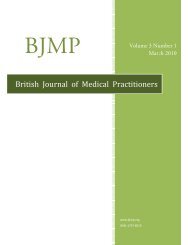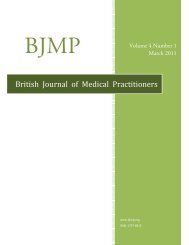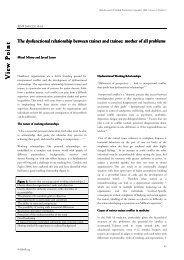R esearch A rticle - British Journal of Medical Practitioners
R esearch A rticle - British Journal of Medical Practitioners
R esearch A rticle - British Journal of Medical Practitioners
Create successful ePaper yourself
Turn your PDF publications into a flip-book with our unique Google optimized e-Paper software.
<strong>British</strong> <strong>Journal</strong> <strong>of</strong> <strong>Medical</strong> <strong>Practitioners</strong>, March 2013, Volume 6, Number 1<br />
separate teams <strong>of</strong> nurses and key workers. Supervised<br />
administration was provided by local retail pharmacies.<br />
In October 2010 key workers were provided with list <strong>of</strong> patients<br />
currently under their care and asked to identify patients they<br />
thought were using heroin regularly. A r<strong>esearch</strong> assistant then<br />
checked case notes <strong>of</strong> identified patients, looking at selfreported<br />
heroin use as recorded in TOP monitoring forms, and<br />
at the results <strong>of</strong> previous urine toxicology tests. Those whose<br />
most recent TOP was performed at entry to treatment were<br />
excluded (since their self-reported heroin use covered a time<br />
when they were not in treatment). Among the remainder<br />
patients reporting use <strong>of</strong> heroin on at least 8 days in the 4 weeks<br />
preceding their last TOP interview were classified as “nonresponding”<br />
patients. The case notes <strong>of</strong> all identified “nonresponders”<br />
were reviewed using an audit tool covering age, sex,<br />
postcode, date <strong>of</strong> entry into treatment, duration <strong>of</strong> treatment,<br />
dose <strong>of</strong> medications, extent <strong>of</strong> supervised administration, dates<br />
and results <strong>of</strong> recent urine toxicology, and date and selfreported<br />
drug use from previous TOP questionnaires. This data<br />
was collected at baseline and again at re-audit (follow-up) 9<br />
months later.<br />
Establishing the medical reviews in one <strong>of</strong> the two clinics was<br />
necessary for logistic reasons, but it also allowed an opportunity<br />
to assess the impact <strong>of</strong> the reviews, by comparing the outcomes<br />
<strong>of</strong> non-responders in the two clinics. If effective, it was<br />
proposed to extend this approach to the second ‘treatment as<br />
usual’ service. Referrals for medical review ceased in June 2011,<br />
and over the next three months staff feedback about the process<br />
was sought. In October 2011 a repeat audit <strong>of</strong> case notes<br />
including TOP results <strong>of</strong> all previously identified nonresponders<br />
at both services was undertaken.<br />
At follow-up data on the frequency <strong>of</strong> medical appointments in<br />
the preceding 6 months were also collected. In cases where<br />
people had left treatment, the TOP performed on exit from<br />
treatment was used. Those non-responders who had left<br />
treatment were identified and tabulated according to the reason<br />
for leaving treatment.<br />
Flowchart 1: The audit and re-audit process<br />
Postcodes were used to derive Index <strong>of</strong> Multiple Deprivation<br />
(IMD) scores 11 . The English index <strong>of</strong> multiple deprivation<br />
(IMD) is a measure <strong>of</strong> multiple deprivations, with domains<br />
including employment deprivation, health deprivation and<br />
disability, education skills and training deprivation, barriers to<br />
housing and services, living environment deprivation, and<br />
crime.<br />
In one clinic, the “implementation clinic”, beginning January<br />
2011, key workers were asked to refer all non-responders for a<br />
medical review. Patients were also screened for comorbidity,<br />
taking advantage <strong>of</strong> a separate project running concurrently<br />
which was designed to test the psychometric properties <strong>of</strong> a new<br />
questionnaire on mental health and well-being. All service users<br />
at the implementation clinic were invited to take part. The<br />
study had National R<strong>esearch</strong> Ethics approval and approval from<br />
the Merseycare NHS Trust R&D Office. Quality <strong>of</strong> life was<br />
assessed with the EQD 12 which comprises 5 domains measuring<br />
health-related quality <strong>of</strong> life: mobility, self-care, usual activities,<br />
pain/discomfort, and anxiety/depression. Depression was<br />
screened for with the Beck Depression Inventory 13 .<br />
UK guidelines recommend for patients doing poorly “..ensuring<br />
medication is provided within evidence-based optimal levels,<br />
changing to another substitute medication, increasing key working<br />
or psychosocial interventions and increasing supervised<br />
consumption” 3 . The recommended dosage for effective<br />
treatment is listed as in the range 60-120mg/day <strong>of</strong> methadone.<br />
At medical review, the plan was for the doctor to assess the nonresponding<br />
patients, and propose raising methadone dose<br />
progressively until heroin use ceased, or a maximum dose <strong>of</strong><br />
120mg/day was reached; and requiring supervised consumption<br />
<strong>of</strong> methadone for patients persisting in heroin use.<br />
Ethics<br />
The audit was approved by the local NHS Trust R&D Office.<br />
Funding was obtained to undertake the work by Mersey Care<br />
NHS Trust.<br />
Analysis<br />
Data was entered into SPSS version 18 (for windows).<br />
Summary statistics and standard hypothesis tests compared non<br />
responders in the intervention service to non responders in<br />
treatment as usual to ensure there were no statistically<br />
significant differences between the two groups at baseline. Chisquare<br />
and t-tests compared age, sex distribution, IMD scores,<br />
methadone dose and months in treatment this episode. Mann-<br />
Whitney U tests compared the number <strong>of</strong> TOP forms<br />
completed in each group during the previous 6 and 12 months.<br />
Regression analysis explored whether there was a relationship<br />
between attendance for supervised administration, self-reported<br />
quality <strong>of</strong> life and depression for non responders in the<br />
BJMP.org<br />
7







